How Liverpool's St George's Hall played its part in World War One
- Published
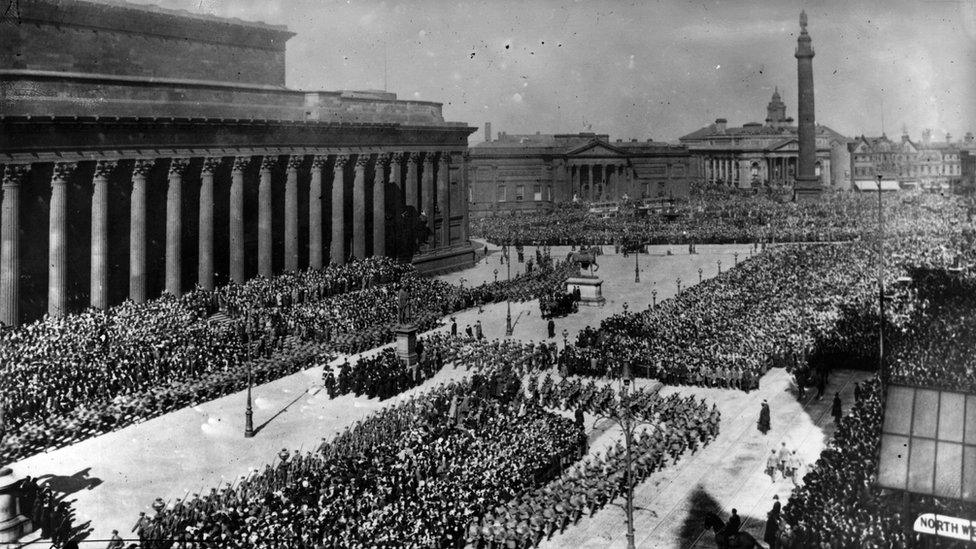
About 12,000 soldiers paraded outside St George's Hall in March 1915
The eye-catching cascade of ceramic poppies displayed last year at the Tower of London is about to be exhibited in Liverpool ahead of Remembrance Sunday. Known as the "weeping window", it will be draped down St George's Hall. But what is the building's link to World War One?
A Liverpool landmark, the neo-classical edifice - and its large plateau - has been the city's main gathering point in joy and sorrow since its completion in 1856.
The writer Charles Dickens, who gave readings in the building, external, declared St George's Hall's concert room to be "the most perfect room in the world" but alongside it, the hall also hosted the city's civil and crown courts.
"It was a curious mixture of the great affluence of the Victorian age - the most expensive events that took place outside of London and people being sentenced to death. It's bizarre," says St George's Hall historian Steve Binns.
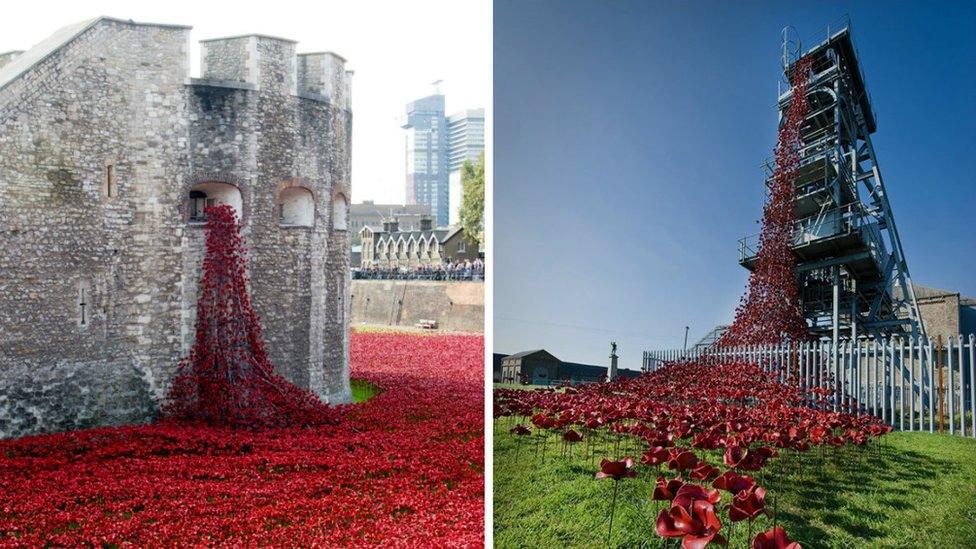
The Weeping Window was part of the Blood Swept Lands and Seas of Red display at the Tower of London and was at Northumberland's Woodhorn Museum recently
On 31 August 1914 - a month after World War One broke out - the plateau outside St George's Hall was "packed with thousands of men", from accountants to gas fitters, volunteering to fight, says Tony Wainwright of the Liverpool Pals Memorial Fund.
Major employers in the city each had their own desk, including the shipping companies White Star Line - owners of the sunken Titanic - and Cunard.
Alongside other players such as the Cotton Association and the sugar trade, they formed a "snapshot of Liverpool as a centre of world trade", says Mr Wainwright.
By 10:00, the first 1,000 men had been recruited. By September 1914, more than 30,000 enlisted at St George's Hall.
The scale of the recruitment meant that on one particular day, the hall held 7,000 medical check-ups for volunteers. It led to an unusual mix.
"You got these courts going on, you got medicals going on and you got concerts in the concert room to collect money for the troops and their families," says Mr Binns.

Thousands of Merseyside men signed up at St George's on 31 August 1914
That autumn, the Earl of Derby - considered the most senior Conservative politician in Lancashire and the government's director of recruiting - helped raise four battalions in Liverpool.
He coined the term "Pals battalions" as men could enlist with friends and neighbours, and the scheme - first tested in London - started to spread.
In March 1915, he joined War Secretary Lord Kitchener - famed for his finger-pointing "Your country needs you" poster - at a review where about 12,000 new soldiers paraded outside St George's Hall.
Later on in the war, the events at the venue could not have had a more different purpose.
"They used it for tribunals to decide on conscientious objection and they were very fierce. Anyone who refused to go [to war] would face a tribunal," explains Mr Binns. Across the country, more than 5,000 conscientious objectors were jailed, external at least once during WW1.
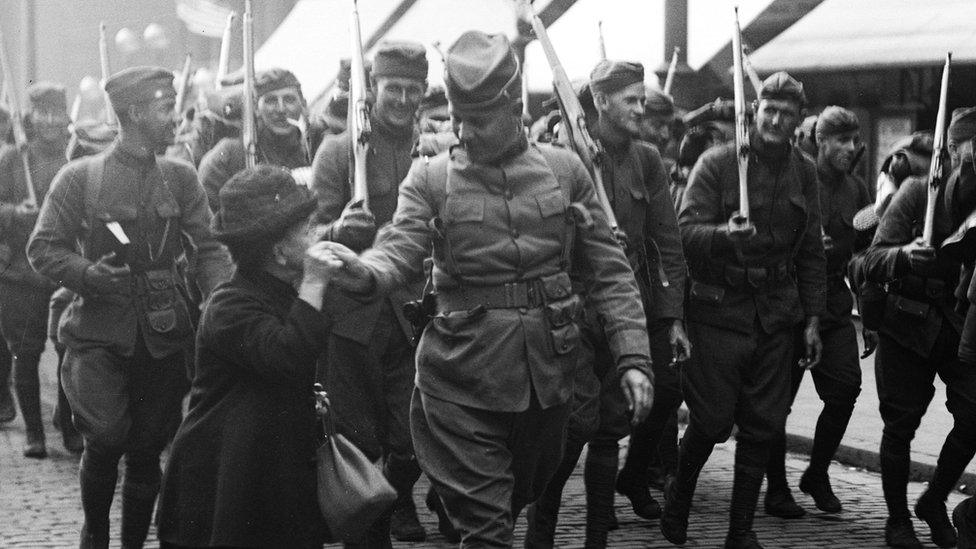
A woman kisses the hand of an American soldier arriving in Liverpool in 1918
Situated in a port city, St George's Hall held inquiries into the loss of wartime ships, although the investigation into its largest - when the 1915 sinking of the Lusitania led to the deaths of 1,200 people - was held in London.
But war weariness was tempered by the triumphalism and curiosity of seeing captured German military machinery.
Crowds flocked to St George's plateau to see a gun in November 1915 and, less than a year later, a Fokker plane was displayed outside the hall before it was moved inside with other war memorabilia because of high winds.
In 1917, "Julian" the tank rolled on to the plateau to advertise war savings so people could "feed" it with their bonds. King George V and Queen Mary also presented some military models when they visited in the same year.
After US soldiers arrived by ship in 1917, the hall put on concerts and a Thanksgiving service, with troops parading on the plateau.
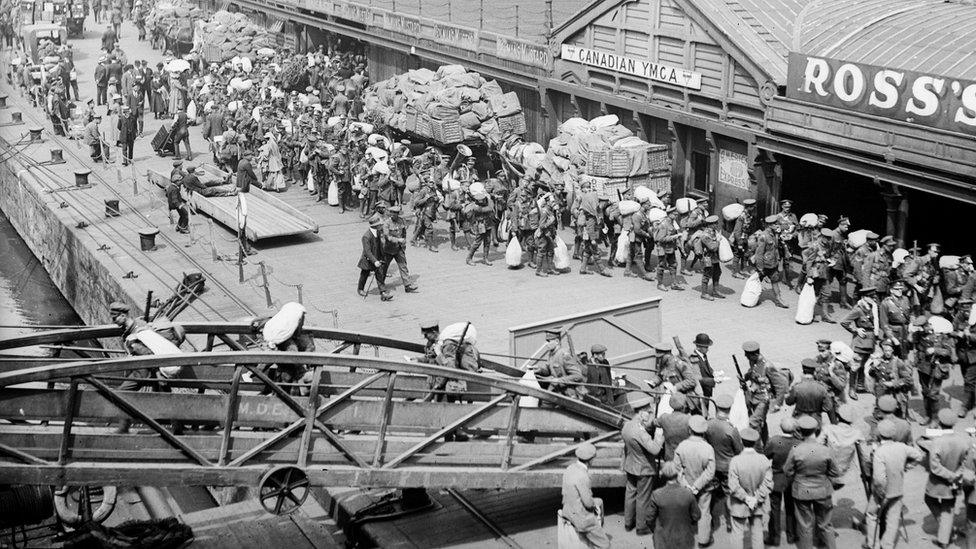
After the war, thousands of Canadian and US troops returned home via Liverpool
When war finally ended in 1918, thousands of locals gathered at St George's and clambered on to the lamp-posts in celebration, says Mr Binns.
"People gather at St George's without being told. Every city worth its name has got to have a place where people will go without the permission of their government or their establishment.
"Most demonstrations will be held outside. If someone has died, they will gather outside."
For survivors who returned to the city by train, St George's Hall would have been one of the first buildings they saw as they came out of Liverpool Lime Street station.
Although he works for the stunning venue, Mr Binns admits to preferring Liverpool's Town Hall. But he says that doesn't stop him from believing St George's Hall is "the most important building in the development of this city's history".
The first poppy of the Weeping Window will be planted in Liverpool on Tuesday. The display opens to the public on Saturday

Poppies come to Liverpool
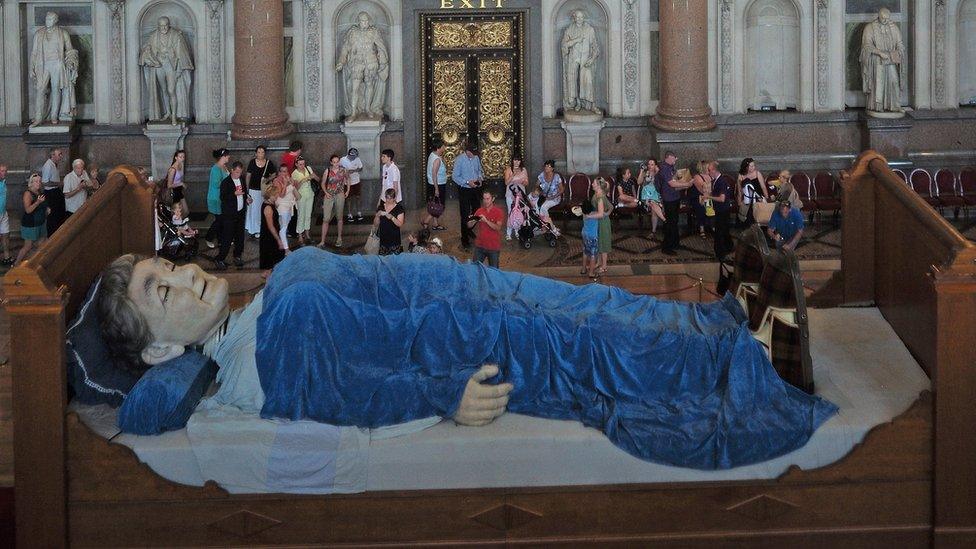
St George's Hall hosted a giant puppet in an event marking the WW1 centenary in 2014
More than five million people saw the 2014 installation of ceramic poppies at the Tower of London
Created by artists Paul Cummins and Tom Piper, each of the 888,246 poppies represented each death in the British and Colonial forces between 1914 and 1918
About £9m was raised for military charities after most of the poppies were sold to the public but two sections - the Wave and the Weeping Window - were bought for the nation by the charities Backstage Trust and the Clore Duffield Foundation
St George's Hall is a popular focal point, where thousands gathered after the deaths of The Beatles members John Lennon and George Harrison, and more than 65,000 saw the European Capital of Culture launch in 2008, external
The plateau also features the Liverpool Cenotaph, established in 1927, which was recently awarded Grade I status - more than 13,000 men from Merseyside died during WW1
About 40,000 visited the Grandmother Giant inside the hall in 2014 when massive puppets were used to mark the WW1 centenary
The Weeping Window was on display at Woodhorn Museum in Northumberland in the past two months, attracting 120,000 visitors

- Published1 November 2015
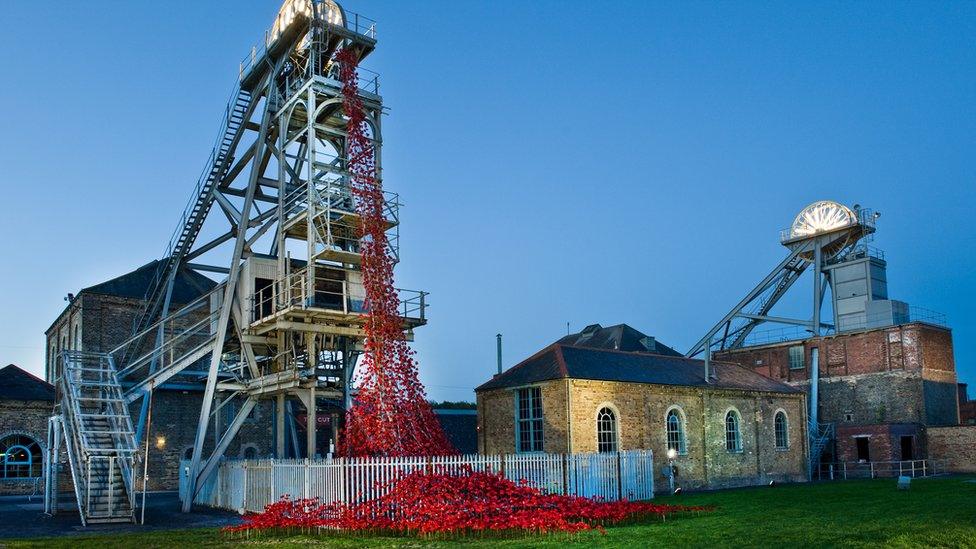
- Published19 October 2015
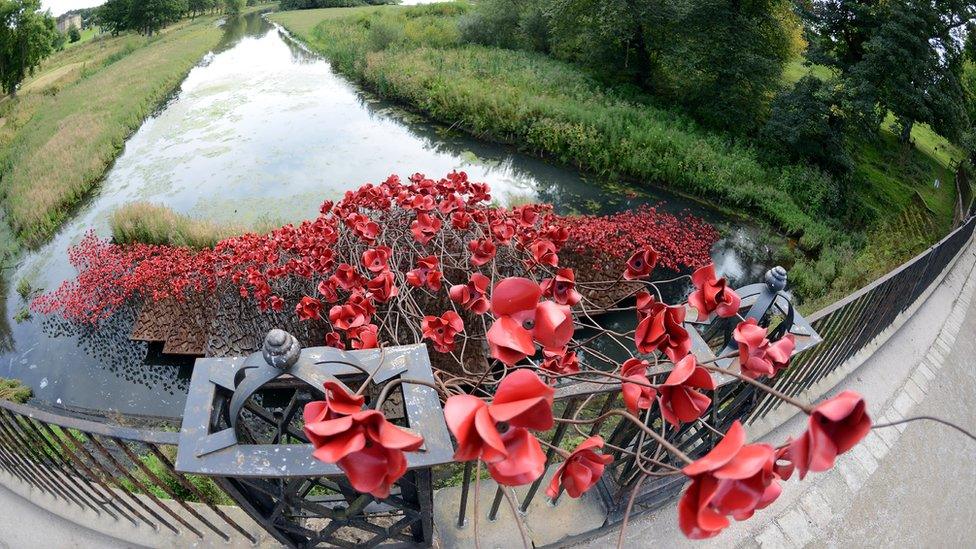
- Published11 September 2015
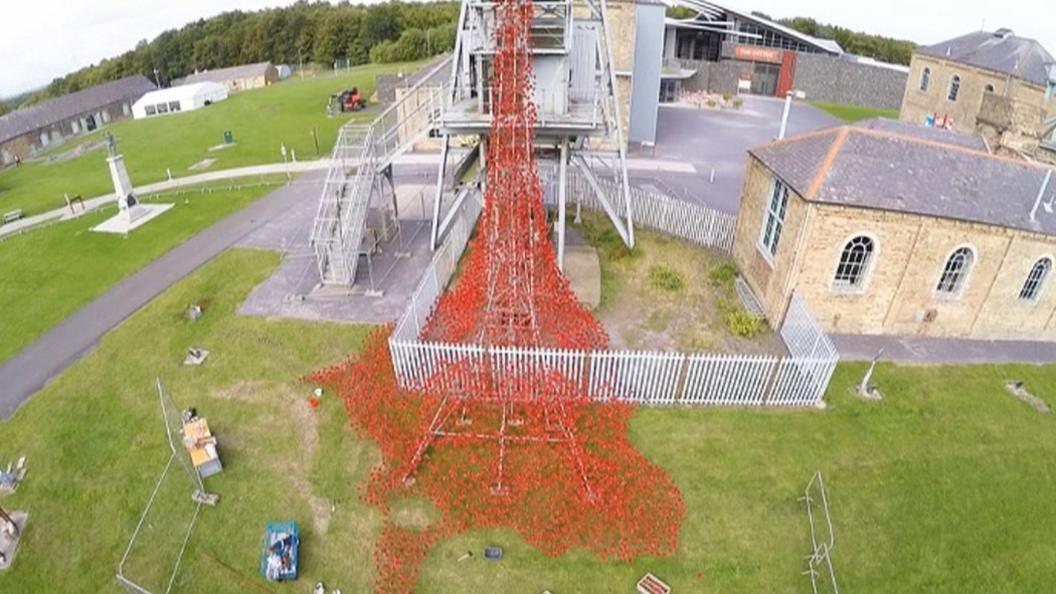
- Published30 July 2015
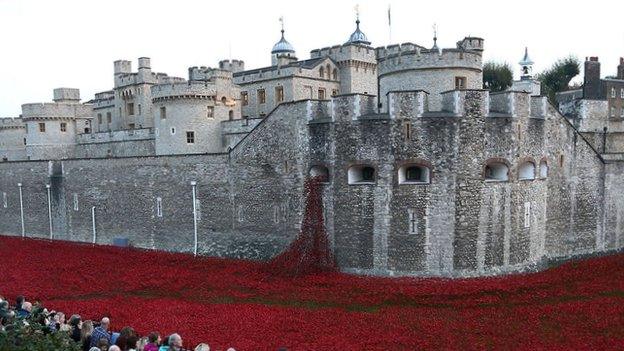
- Published5 August 2014
